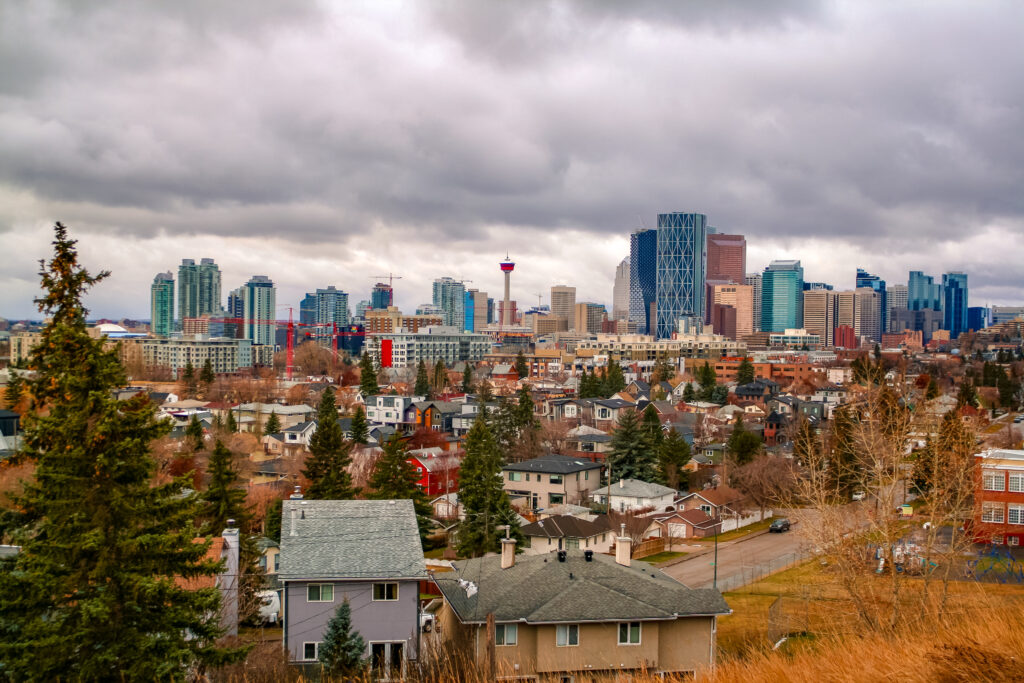Written by Jaelyn Molyneux BA’05
Dr. Sasha Tsenkova is a professor at the University of Calgary’s School of Architecture, Planning and Landscape and director of the Cities, Planning and Policy Lab where she specializes in sustainable cities, urban planning and growth management — all topics that find themselves headline news these days as more housing becomes unaffordable or even unavailable.

In fact, she’s literally written the book (10 books, actually) on housing and urban development.
Tsenkova, PhD, says the housing affordability issue is the result of “a constellation of so many different facets of our life, and especially in cities.
“It’s not going to be solved this week or next month. It’s one of these wicked problems that’s a systemic issue.”
Tsenkova says there are no quick-fix solutions on the horizon, but there are a few things to consider as the discussion around affordable and sustainable housing heats up, finally, and not a moment too soon.
Housing has skewed our debt-to-income ratio. It wasn’t always like this
The debt-to-income ratio is how much you owe, compared to how much you earn. At the beginning of 2023, it was 184.5 per cent in Canada. Any debt-to-income ratio above 43% is considered to be high and even unsafe.
The cost of an average home used to be around three times household income. Now, in hot markets like Vancouver or Toronto, it can be up to 15 times. In Calgary, where the median family income is $118,000, the City released a Housing Needs Assessment Report in early September 2023 that states the median single-family home is five or six times that at $645,000. That’s a 37-per cent increase from 2020.
“If you start to cross certain points, for example, in Greater Toronto where a commute to work is more than 45 minutes one-way, that’s when people really start to revolt and start to pay attention.”
That massive imbalance has a combination of reasons. Salaries haven’t increased at the same pace as housing costs, which are higher because construction costs are up. There are labour shortages. Commitments to decarbonization and sustainability raise costs, as do our demands for higher quality and all the jazzy high-tech bells and whistles of housing.
“But that’s not the real issue. The real issue is the cost of capital and borrowing costs for mortgages going up exponentially,” says Tsenkova. “People are really squeezed out of the marketplace.”
The interest portion of mortgage payments is 70-per cent higher than it was a year ago.
But that squeeze could be worse. Canadian homeowners in the 1980s will remember double-digit interest rates (compared to five per cent, where it sat as September 2023 began). “That’s when people tend to walk away from their homes. It is no longer an asset; it’s a liability,” says Tsenkova. “We don’t want to get to that point because that triggers a cycle of disinvestment.”
The cost of suburban Canada
In Canada, we have land. Lots of it. We are a suburban nation. But continuing to sprawl into that land for housing is expensive.
“There’s a whole bundle of services that make urban land something that can be built on,” says Tsenkova. Think sewer systems, electricity, roadways. “There also needs to be access to employment, education, retail — the elements that constitute quality of life and urban living. It’s a false assumption that we just need land to roll out a red carpet of single-family homes.”
Once you build it, it must be maintained. Increasingly, as the climate becomes more extreme, that maintenance gets more expensive and aging infrastructure needs to be replaced. Those ongoing costs continue to pile up on civic budgets and factor into development decisions and housing costs. They also increase our infrastructure deficit.
The transportation equation
Developments that stretch into the suburbs set the stage for a society that has a much more fragmented way of living and is prepared to be stuck in traffic and lose a lot of the productive time in the day. “That is a very high social cost to the person, the individual, the family, but also to society to maintain,” says Tsenkova. About 30 per cent of urban land is dedicated to transportation; 50 per cent goes to housing; and the rest is for parks, retail, community centres, etc.
So far, in Canada it’s a cost we are willing to pay as we continue to trade longer commutes for bigger houses. Sure, we complain about traffic, but we aren’t at the tipping point where it significantly impacts real estate decisions in Calgary.
“There is empirical evidence,” says Tsenkova. “If you start to cross certain points, for example, in Greater Toronto where a commute to work is more than 45 minutes one-way, that’s when people really start to revolt and start to pay attention. In Calgary, we still have a very reasonable threshold, but it is time to start building better and more livable neighbourhoods.”
Canadians need to think smaller
Canada is second in the world in terms of housing consumption per person. The average size of a home has doubled since the 1970s. That means our homes are big. Almost certainly too big for a lot of us.
“Do we need all of these McMansions with five bedrooms where every child gets a bedroom and a bathroom?” asks Tsenkova. “In many more-affluent countries around the world, including Switzerland, France, Germany or England, that is not really a requirement.”
She says there is a classic mismatch of the marketplace that is helping contribute to the supply shortage.
“Too many homes are vacant or under-occupied, while too many people are without homes,” Tsenkova says. “There are five-bedroom homes with two people living in them. On the other hand, you have people looking for a start. Maybe they just moved to the city or are looking for their first job. They don’t necessarily want a big home. There are a lot of inefficiencies in distribution.”
Missing rungs on the ladder
In Calgary, our housing mostly falls into two buckets — big single-family homes and small condos. We’re missing the middle that allows you to enter housing and progress as you age, or your family grows or your circumstances change. We’re also missing diversity of different types and tenure forms, which would allow for people from different walks of life and cultures to live in their home.
“We need a lot more non-market housing. Not just public, but also housing that is good-quality where people could transition from something that is deeply subsidized to something that is more midstream, and then beyond,” says Tsenkova. “That is the idea of a housing career or housing ladder. You’re not really forced to go into home ownership, when it’s a half-baked solution, and you just about qualified for a mortgage, but interest rates changed and you were forced into a default situation. It’s a question of diversity of tenure and also of choice. There are options out there such as co-housing, co-operatives and shared ownership, to name a few.
“Everyone has to have a home. Not everyone has to be a homeowner of a single-family home with a double and triple garage and an office.”


Condos are a ticking time bomb
As for the condo market, seen by many as an alternative to single-family homes without the maintenance, Tsenkova compares it to “a ticking time bomb.”
“They are growing higher and higher and becoming much more complex without necessarily ensuring that sector can be managed effectively,” she says.
Tsenkova points to places like Vancouver and Toronto and even Calgary where condos are taking up a higher segment of the marketplace and the scale is supersized, with thousands of residential units in a handful of buildings. SkyTower in Toronto is set to open in 2024 with a 95-storey residential building, for example. In Calgary, Waterfront is a master-planned, mixed-use community in Eau Claire along the Bow River downtown. It is Calgary’s single largest condominium development at more than one million square feet, with 19,213 sq. ft. of retail and 1,000 residential units.
“How do you manage such developments on a voluntary basis, with an elected board of directors that hires a property management company?” says Tsenkova. “There are all sorts of structural, financial and behavioral issues and complications. It really brings in a lot of uncertainty and higher costs, life-cycle and special-needs assessments and regulatory challenges.”
She prefers smaller, more autonomous units so, if one fails, it doesn’t bring down the whole block. “It’s about resilience,” says Tsenkova.
Affordable housing is an issue for all levels of government
Municipal governments manage the land, plan and deliver infrastructure, and steer development. Provincial and federal governments provide low-cost financing, grants and fiscal incentives. They also help non-profits that run rental and affordable-housing programs.
“Different strategies and opportunities need to align to leverage the powers of all levels of government,” says Tsenkova. “It’s about a partnership of different levels of government — meaningful partnerships for the long term. That would provide a more-balanced marketplace where not everyone is going into home ownership chasing an expensive commodity, outbidding each other during a boom and being stuck with it when there is a decline.”
It wasn’t until 2019 that the federal government passed the National Housing Strategy Act that recognized housing as a human right and created a 10-year plan to help Canadians access housing.
Tsenkova is happy that we are talking about it more, but it’s been a long time coming and she wonders if it is too little, too late.
“We have seen a lot of lot of programs, a lot of rhetoric, cutting ribbons here and there, and announcements. But it just requires a lot more than that; it is a commitment to livable and inclusive cities,” she says.
Calgary’s new housing strategy
The City of Calgary approved a new housing strategy in September 2023. It marks an important milestone, providing a seven-year road map to increase Calgary’s market and non-market housing supply at a time when one in five Calgary households is struggling to afford shelter.
“The investment in 3,000 non-market homes per year will provide more opportunities for affordable rental for vulnerable and often-marginalized people,” says Tsenkova. “In addition, the change in zoning allowing intensification of existing neighbourhoods will increase and diversify the supply of housing, providing duplexes, townhomes and walk-up apartments for people with different needs.”
Tsenkova says effective partnerships of all levels of government with the private sector are necessary in the implementation process.
“Enhancing collaboration from planning and designing to improving construction efficiency, access to social infrastructure and funding will be critical to deliver affordability,” she says. “Higher density and the market alone would not provide affordable housing or socially integrated housing supply.”
Vienna, Austria, is an example of a city playing the long game. More than 60 per cent of its people live in subsidized housing. Nearly half of the housing market is city-owned or co-operative apartments. That focus on aggressively weaving affordable housing into Vienna began a century ago and has held steady. Social housing is an integral part of every neighbourhood and is a place for innovation and experimentation in terms of quality, energy-efficiency, sustainability and design excellence.
Paris, France, is one of the most expensive cities to live in, but, by the end of 2021, it had succeeded in making 21 per cent of its accommodation accessible to people with lower incomes through social housing. It’s increased that target to 30 per cent by 2030 and plans to get there by building new social housing, requiring 25-per cent social housing in any new project and converting empty offices, schools and garages into homes. By comparison, in Calgary, 3.6 per cent of housing is non-market affordable housing.




